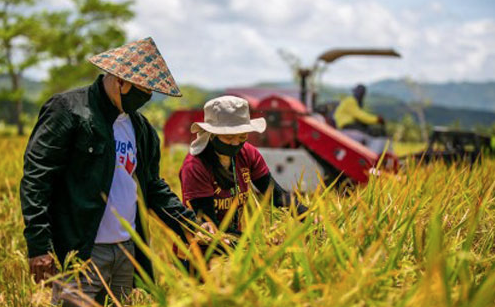
The Philippines remains to be one of the top rice producers in the world, maintaining its 8th place behind China, Indonesia, India, and other Southeast Asian nations. To improve rice production and assist Filipino farmers in improving crop durability and yield, rice research is constantly being done at different institutes and universities around the country.
From developing different rice varieties to improving the maturation process of rice crops as a way to mitigate climate change impacts on rice production, rice researchers are constantly putting out studies to strengthen the rice industry in the country, as well as equip farmers with technological advancements and techniques to promote their agricultural resilience.
14 New Rice Varieties Developed by IRRI, PhilRice
In line with the continuous efforts to revive Philippine rice production, IRRI and PhilRice, in collaboration with the University of the Philippines Los Baños, submitted 14 new inbred and dry-seeded rice varieties in 2015, which were then approved by the National Seed Industry Council.
Among the newly released varieties, four inbreds—NSIC Rc394, Rc396, Rc402 and Rc414—and five dry-seeded—NSIC Rc416, Rc422, Rc424, Rc426 and Rc430—were developed by PhilRice.
These varieties vary depending on their maturation age and yield, with the NSCI Rc394, NSCI Rc396, and NSIC Rc402 yielding between 5.1 to 5.5 metric tonnes per hectare and taking up to 106 to 107 days to mature for early harvest. These variations largely dictate how farmers navigate stronger, more devastating typhoons without their crops becoming collateral damage.
According to PhilRice Breeding and Biotechnology Division Head Norvie Manigbas, “The earlier the varieties mature, the earlier they are ready to be harvested. Our farmers can harvest and thresh the crop before strong typhoons or heavy drought come.”
Other rice variants also come in dry-seeded varieties, which are specifically designed to be resilient in pest-prone conditions. These varieties have higher resistance to common rice pests and diseases, such as bacterial leaf blight, blast, green leafhopper and white and yellow stemborer.
PhilRice Promotes Planting of Drought-Tolerant Rice Varieties
Due to highly unpredictable weather phenomena in the Philippine climate, the Philippine Rice Research Institute has promoted the cultivation of drought-tolerant rice varieties and the utilization of El Niño-ready technologies in paddy-rice production. This is after the Philippine Atmospheric, Geophysical and Astronomical Services Administration (PAGASA) reported the possibility of a long occurrence of El Niño that can linger until next year.
The recommended rice varieties that PhilRice encouraged farmers to plant are early-maturing types, such as the SB Rc10 (Pagsanjan), NSIC Rc130 (Tubigan 3) and NSIC Rc152 (Tubigan 10), which can yield up to 9.8 tons per hectare and mature at a maximum of 107 days. In addition, PhilRice urged farmers to use water-saving technologies, such as controlled irrigation or alternate wetting and drying, aerobic rice, drip irrigation and reduced tillage technology.
SSTS Technology Prolongs Brown Rice Shelf-Life
Alongside the production of rice varieties, rice research has also yielded technological advancements that improve the shelf-life of some rice variants, namely brown rice. Today, brown rice is considered a healthier option for people who are trying to boost their immune system, reduce diabetes risk, and control body weight, which explains its rising popularity. While brown rice does in fact offer better health benefits, it has a shorter shelf-life and a higher chance of spoilage. At maximum, brown rice can only be stored within a month or two, which leads to widespread food wastage.
To address this issue, research specialists from the Metals Industry Research and Development Center of the Department of Science and Technology designed a superheated steam treatment system that stabilizes brown rice. With funding from the Philippine Council for Agriculture, Aquatic and Natural Resources and Development (PCAARRD), researchers found a way to deactivate or slow down enzyme activity, which typically starts in brown rice once the bran becomes exposed after rice processing.
According to Dr. Dominic S. Guevarra, the senior research specialist in charge of the project, they have already obtained the optimum parameters, such as the temperature, treatment time and capacity at which the machines perform best. After subsequent field testing and promotion, the project is expected to provide assistance to fabricators, rice millers and farmers’ cooperatives.
The development of the SSTS machines is also predicted to increase the production and consumption of brown rice in the Philippines and make it more affordable for Filipino families, regardless of their financial status.
Research Improves Rice Production, But Importation Harms the Agricultural Industry
While rice institutes are constantly developing and improving the competitiveness of Filipino farmers, some government moves have made it harder for our local farmers to compete with rice imports that are sold at much lower prices. This is why a lot of researchers and agricultural experts are pushing for mandates that will allow the Philippines to become self-sufficient when it comes to its rice supply.
While research is an important part of supporting Filipino rice farmers, government support still figures largely in establishing rice self-sufficiency. As one of the top rice producers in the world, it serves as an ill omen as the country evolves into the top importer of our farmers’ staple crop – exposing our citizens to widespread loss of livelihood and the country’s eventual dependence on the rice supply of our neighboring countries.
If the government realizes their role in preserving the Philippines’ rice self-sufficiency, not only will the government be able to support local farmers and raise their annual revenue, but they can also prevent rice farmers from shifting to alternative crops that they may deem more profitable in the long run.
Source: https://businessmirror.com.ph/2022/06/01/nsic-okays-14-rice-varieties-developed-by-irri-philrice/













